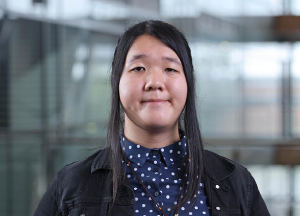
Yow-Ming (Robin) Hu, ANU
Open dissipative systems described by non-Hermitian Hamiltonians have recently attracted a lot of interests as they lead to a wide range of effects such as coherent-perfect absorption and lasing [1], directional emission [1], novel topological invariants [2] and edge states [3]. One of such systems is the exciton polaritons in an optical microcavity which arise from the strong coupling of excitons in a semiconductor and cavity photon modes. The inherent loss and gain in this system have already enabled measurements of non-Hermitian degeneracies [4] and topological invariants [2]. Inspired by recent studies [3, 5] showing the self-acceleration of non-Hermitian wave packets, we theoretically investigate the time-evolution of wave packets in a non-Hermitian exciton-polariton system.
In particular, we numerically study wavepacket dynamics in momentum space and observe self-acceleration. The wave packets tend to evolve into the eigenstate with the smaller decay rate (or the larger imaginary part of the eigenenergy), then propagate towards the momentum corresponding to the minima of the decay rate (or the maxima of the imaginary part of the eigenenergies). We also observe the generation of pseudospin defects (half skyrmions) along the imaginary Fermi arc in momentum space, where the decay rates of the two eigenstates coincide. All of these effects do not require an external potential and can be measured in an exciton-polariton system with optical anisotropy, e.g., perovskite [2], organics [6], or ZnO-based microcavities [7]. Our results highlight the excellent potential of exciton polaritons as a platform to study non-Hermitian dynamics.
[1] Ş. K. Özdemir, et al., Natural Materials 18, 783-798 (2019). [2] R. Su, et al., Science Advances 7, eabi8905 (2021). [3] S. Longhi, Phys. Rev. B 105, 245143 (2022). [4] T. Gao, et al., Nature 526, 554–558 (2015). [5] D. D. Solnyshkov, et al., Phys. Rev. B 103, 125302 (2021). [6] Q. Liao, et al., Phys. Rev. Lett. 127, 107402 (2021). [7] S. Richter, et al., Phys. Rev. Lett. 123, 227401 (2019).About the presenter
Yow-Ming (Robin) Hu is an Honours student working with Chief Investigator Elena Ostrovskaya. Her project aims to characterise the topology of an exciton-polariton system and to show how to calculate and measure its quantum geometric tensor, including complex Berry curvature. This works towards a key objective of FLEET Research Theme 2 Exciton Superfluids to observe, theoretically and experimentally, topologically protected states in an exciton-polariton system.
